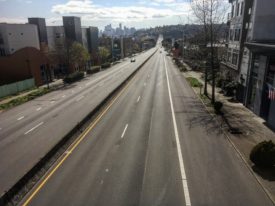 The US federal poverty line is not a good measure of real life poverty. Most researchers agree that the standard method of computing poverty is outdated, overly simplistic, and probably drastically undercounts the number of poor. (Here’s a quick summary from Dan Staley; here’s the longer version of the same story.) Still, despite its glaring flaws, the poverty rate remains the most widely reported gauge of how many poor people there are.
The US federal poverty line is not a good measure of real life poverty. Most researchers agree that the standard method of computing poverty is outdated, overly simplistic, and probably drastically undercounts the number of poor. (Here’s a quick summary from Dan Staley; here’s the longer version of the same story.) Still, despite its glaring flaws, the poverty rate remains the most widely reported gauge of how many poor people there are.
Enter a new report from the Economic Policy Institute (EPI). The report develops a more meaningful poverty rate—they call it a "basic family budget." EPI adjusts for geographic differences in prices—a huge oversight in the federal poverty calcuations—and makes realistic but frugal cost estimates for housing, food, transportation, child care, health care, other necessities, and taxes. Based on these costs, EPI calculates how much money families need to earn just to get by (assuming they don’t save money, go on vacation, or even have renter’s insurance).
You can play with EPI’s handy calculator to get a sense of what their basic family budget is like. A family of 2 parents and 2 children in the Seattle metro area, for instance, needs to earn $45,516 to make ends meet. On the other hand, a family of 1 parent and 1 child in rural Idaho needs just $26,988 per year.
EPI’s report gives an entirely different sense of poverty—and not just because the numbers are much, much higher.
According to the Census Bureau, for example, Idaho has the lowest poverty in the three Northwest states (WA, OR, ID), with just 9.9 percent. But EPI’s more detailed and accurate assessment of economic conditions, makes Idaho by far the worst with fully 37.5 percent of people living in families without enough money for a basic budget.
So not only is Idaho’s "true" poverty situation 3 to 4 times worse than federal estimate suggests, it’s skewed with relation to its nearest neighbors. What’s the explanation here? Does Idaho have a smaller share of very poor people (below the federal poverty line), but a larger share of people who can’t really make ends meet? Or is there something else going on?
Whatever the explanation, I find the comparison troubling, partly because poverty rates are often used to allocate scarce resources.
Washington, on the other hand, has an undistinguished poverty rate for the Northwest, but boasts the smallest share of people unable to earn a basic family budget (see table below). Could this have something to do with Washington’s most-generous-in-the-nation minimum wage?
Here’s a fuller account of federal poverty rates compared to basic family budgets in the Northwest.
|
|
Federal poverty rate, 2004
|
Percent below basic family budget
|
|
Alaska |
9.2 |
28.2 |
|
California |
13.3 |
33.7 |
|
Idaho |
9.9 |
37.5 |
|
Montana |
14.1 |
40.3 |
|
Oregon |
11.7 |
29.9 |
|
Washington |
11.5 |
26.9 |
|
United States |
12.7 |
28.3 |







